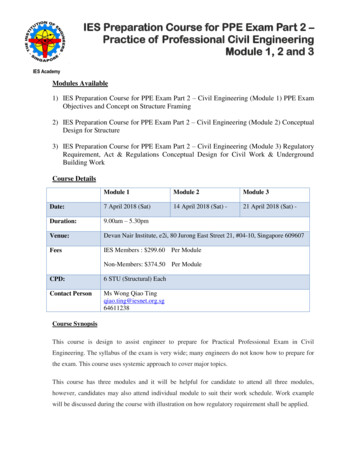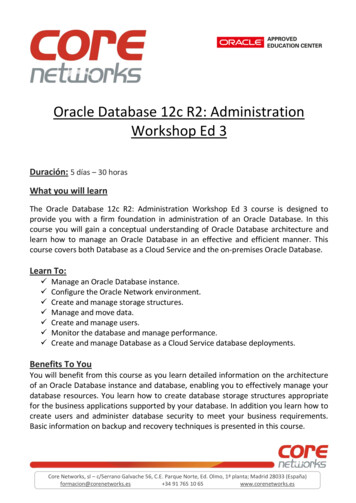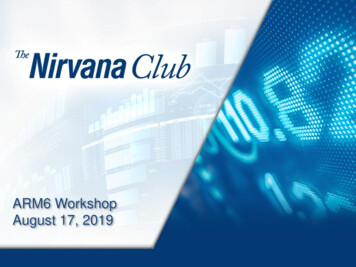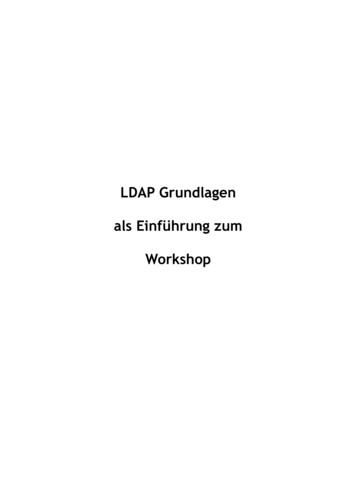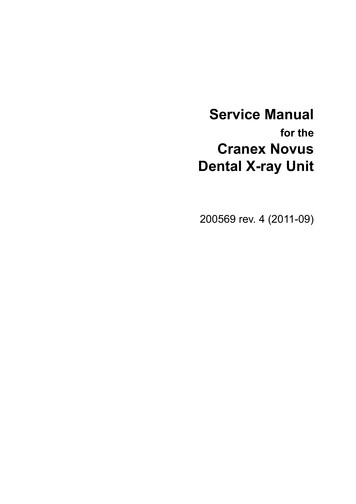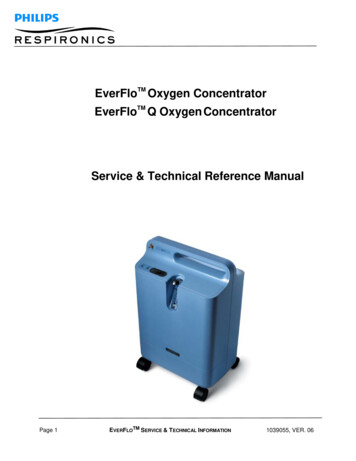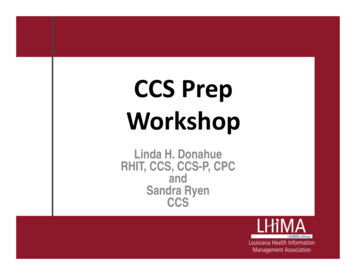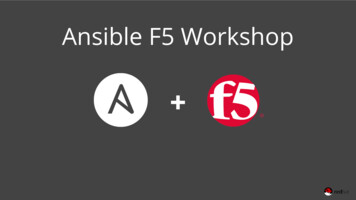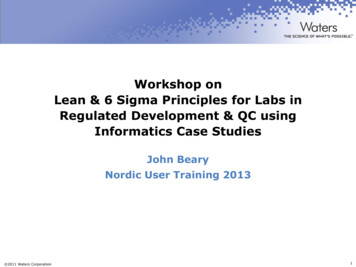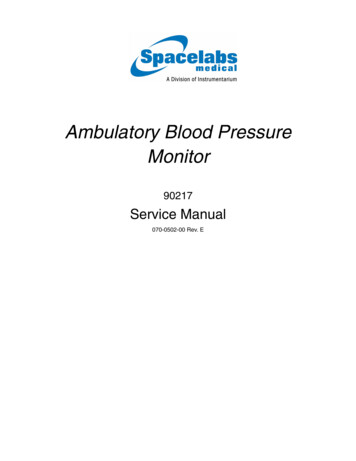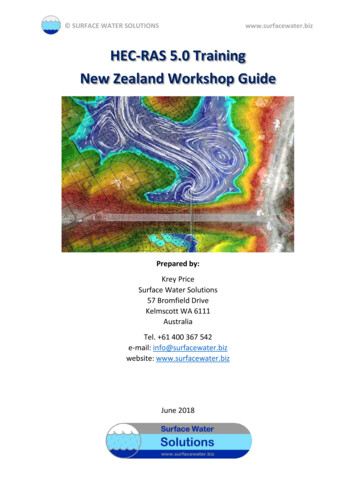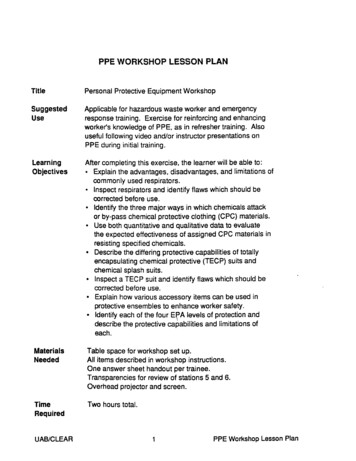
Transcription
PPE WORKSHOP LESSON PLANTitlePersonal Protective Equipment WorkshopSuggestedUseApplicable for hazardous waste worker and emergencyresponse training. Exercise for reinforcing and enhancingworker's knowledge of PPE, as in refresher training. Alsouseful following video and/or instructor presentations onPPE during initial training.LearningObjectivesAfter completing this exercise, the learner will be able to: Explain the advantages, disadvantages, and limitations ofcommonly used respirators. Inspect respirators and identify flaws which should becorrected before use. Identify the three major ways in which chemicals attackor by-pass chemical protective clothing (CPC) materials. Use both quantitative and qualitative data to evaluatethe expected effectiveness of assigned CPC materials inresisting specified chemicals. Describe the differing protective capabilities of totallyencapsulating chemical protective (TECP) suits andchemical splash suits. Inspect a TECP suit and identify flaws which should becorrected before use. Explain how various accessory items can be used inprotective ensembles to enhance worker safety. Identify each of the four EPA levels of protection andIdescribe the protective capabilities and limitations ofeach.MaterialsNeededTable space for workshop set up.All items described in workshop instructions.One answer sheet handout per trainee.Transparencies for review of stations 5 and 6.Overhead projector and screen.TimeRequiredTwo hours total.UAB/CLEAR1PPE Workshop Lesson Plan
ProcedureSet up exercise as described in instruction set beforeclass.Hand out answer sheets and introduce exercise (1 O min.).Allow class 40 minutes to complete stations 1 through 9.Conduct detailed review and discussion of stations 1through 9 (40 min.).Break class for 1O minutes and set up for part on Levels ofProtection.Allow class to gather PPE ensemble components (1 O min.)Allow each team to present their level, followed byquestions and discussion with rest of class (1 O min).TraineePrereq uisitesBasic knowledge of classification, selection, and use ofPPE as provided through previous training or introductoryvideo or instructor presentation.AdaptationforSpecificGroupsExercise can be modified by placing different items at keystations. For example, for site worker trainees who onlyuse Level C PPE, an APR could be replace the SCBA forinspection at station 4. Likewise, a splash suit couldreplace the TECP suit at station 8.UAB/CLEAR2PPE Workshop Lesson Plan
PERSONAL PROTECTIVE EQUIPMENT WORKSHOPTrainer Instruction SetThis exercise is intended as an alternative to a lecture format forreviewing and reinforcing basic knowledge related to PPE. It is set up toroughly follow the order of topics as presented in the PPE modulescurrently used by UAB/CLEAR. This exercise should be followed by theexercise in levels of protection (attached).This is a practical exercise and requires that an exercise area be set upwithin the classroom or some other room. Each exercise station isdesignated by a station sign and equipped with the items listed below.Students rotate from station to station and perform the tasks as requiredto complete the answer sheet (attached). After completion of theexercise, the instructor leads the class in a review of each station. In sodoing PPE-related learning objectives can be achieved.The stations should be supplied with the following items:Station 1:1 half-mask twin-cartridge air-purifying respirator, equippedwith organic vapor cartridges.1 full-facepiece canister-type air-purifying respiratorequipped with an organic vapor canister.Station 2:1 fullface supplied air (or airline) respirator, with or withoutan escape air supply (note that the answer to part D variesaccording to the presence or absence of this feature).Station 3:1 fullface pressure-demand self-contained breathingIapparatus.Station 4:1 self-contained breathing apparatus which has severalobvious defects such as the following:- air cylinder well past date for hydrostatic pressure retest.- air supply low (e.g. approximately 1000 psig.).- clouded, scratched, or crazed facepiece visor- twisted, improperly attached harness.-damaged or missing exhalation valve.- etc.UAB/CLEAR1PPE Workshop Instructions
Trainer Instruction Set, ContinuedStation 5:Several copies of drawings labeled A, B, and C depictingdegradation, penetration, and permeation of chemicalprotective clothing (attached).Station 6:Several copies of the Quick Selection Guide to ChemicalProtective Clothing by Forsberg and Mansdorf (availablefrom Van Nostrand Reinhold) showing qualitative data onchemical protective materials.Vendor information from Life-Guard(attached) showingquantitative data on chemical protective materials.Station 7:1 totally-encapsulating chemical protective suit1 chemical-protective splash suitStation 8:1 totally-encapsulating chemical-protective suit which hasvarious defects such as the following:- damaged seam(s)- missing or damaged exhalation valves- abrasion or other physical damage to suit material (e.g. atorn glove)- visible evidence of previous chemical exposure in one or twosmall areas (e.g. a butyl suit splashed with kerosene intowhich a small amount of used motor oil has been dissolved,then removed leaving an area of discoloration)- components not properly attached (e.g. hardhat-to-suitattachments which are broken or not fully connected)(e.g. boots or gloves which are not properly attached to suit)- physical abrasion to the right knee- chemical degradation to the left knee (which can be producedby exposing the material to sos:ne product such as paintstripper to produce degradation, then decontaminating thegarment.NOTE: It may be advisable to label the knees of the pants toprevent confusion about which is which.Station 9:Various accessory items for PPE ensembles or other types ofsafety equipment, such as- cooling vest-duct tape- two-way radio (respirator compatible)- harness and lifeline- flash coverUAB/CLEAR2PPE Workshop Instructions
Trainer Instruction Set, ContinuedFor this workshop to be fully effective, it must be followed by thoroughclass discussion. The instructor should guide discussion into relevanttopics related to PPE. This will insure that learning objectives areachieved. For example, in reviewing station 6, instead of merely pointingout the correct answers, the instructor should lead the class in adiscussion of basic concepts of CPC selection. This should includediscussion of the potential problems involved in CPC selection.Questions, comments, and suggestions for improvements related to thisexercise should be directed to Alan Veasey at The Center for LaborEducation and Research, 1044 11th St. South, Birmingham, AL35294-4500.UAB/CLEAR3PPE Workshop Instructions
sTATCPCMATERIALcBALIQUIDPRODUCTON OUTSIDEOF SUITCPCMATERIALCUT IN CPCMATERIAL0N5LIQUIDPRODUCTCPCMATERIAL
--STATION 6, Part CChemical Permeation Test Results (ASTM F739 Method)- LIFE GUARDBUTYL tone125Acetonitnle120Carbon Disulfide2----- D1chloromethane4Diethylam1ne3Dimethylformam1de 480- - - - - - - - - - - - - ------- - - - Ethyl Acetate28--- n-Hexane4Methanol303N1trobenzene 480Sodium Hydroxide 480Sulfunc Acid)480-------- Te1 �·Perm Rale(;1glmin cm1LIFE GUARDNfOPRENE MATERIALAverage·Brea"hroughl 1me nunule;Average··Perm Rare(pglm111 cm1)LIFE minule19011834-1201429)4803803805-- -- ------ - - - 16163358365275671316107060 480----- - - - - - ---- - - - - 172134919- - - - - - - --------- )4804872080392210314549 4800 4800 4800)4800 -- )48001017967 480 - - - ----- 1153722333)48077092012 ------- -- Average··Perm RJle(pglm1n cm'11-0 -- 101---- 1430--·16- ------ -------0--- -100 -0---- 0- --- 1030-- - ---- Average 11rne 1n m1nures between contacr of chemical on outside of material surtace dnd de1uct1tH1 ul cl1ern1cal 011 111s1de surlace Average rate al which t11e chemical permeates the mdteriat1:11t1ur CJI 111ese llldlenals w1ll l/.;urJ. 1r 1 ,JI J,Hlu , 1lr11 ;i1ludli011 d 1,·1dll t 1 lll 1111 r11,1tt r1cd ·,111 i1il1 Ibe tested aga11151 lhe chemical hazard1here art uses ano c.hemicals tor w1·11cl1 l11e t: KCt:JJ( 111t: ,J11· un5LHldl)IC It 1 U1e re pnn :J1lJ1!1l·, r ;I 111. 11 .er tu ·c rill 1r 1dl 111v,l: 1!1·111 . dlt· .1 1 · ,r, ·I ir1,Jl 11 ,1tl1e intended u;e ancJ meet a1111eallt1 stancJardclests performed by Rad1dt1 Corporation Before decir11r1 11t
PERSONAL PROTECTIVE EQUIPMENT WORKSHOPAnswer SheetSTATION 1: RESPIRATORY PROTECTIVE EQUIPMENT(A) Observe the two respirators on display at this station. These areexamples of what type of respirator?(B) List any advantages you can think of which this type of respirator mayoffer, as opposed to other types of respirators.(C) List any disadvantages of this type of respirator.(D) Both the respirators at this station are equipped to protect thewearer against organic vapors. Which of the two should offerprotection against the highest concentration of organic contaminantsand why?STATION 2: RESPIRATORY PROTECTIVE EQUIPMENT\(A) What type of respirator is on display at this station?(B) List any advantages you can think of which this type of respirator mayoffer as opposed to other types.(C) List any disadvantages of this type of respirator.UAB/CLEAR1PPE Workshop
(D) Is this item suitable for use during IDLH entries?Why?STATION 3: RESPIRATORY PROTECTIVE EQUIPMENT(A) What type of respirator is on display at this station?(8) List any advantages you can think of which this type of respirator mayoffer as opposed to other types.(C) List any disadvantages of this type of respirator.STATION 4: SCBA INSPECTION(A) Visually inspect the SCBA carefully and note any flaws which shouldbe corrected before the unit is used in a contaminated area. Listthree flaws in the spaces provided below.Flaws:(B) Based on the SCBA air supply as indicated by the cylinder gaugereading, provide the following information.Approximate Cylinder Gauge Reading (psi):Estimated Total Breathing Time Remaining:(HINT: Allow I minute per 100 psi gauge pressure.)Estimate of Breathing Time Before Alarm Sounds:(HINT: Alarm should go off at about 550 psi.)UAB/CLEAR2PPE Workshop
STATION 5: CHEMICAL ATTACKS ON CPCThe figures displayed at this station represent three different ways inwhich chemicals may attack or bypass chemical protective garments.Match the letters from the drawings with the three types of chemicalattack listed below.permeationpenetrationdegradationSTATION 6: CPC SELECTIONUse the provided information sources on chemical protective materials toperform the tasks and answer the questions listed below.(A) Use the Quick Selection Guide to Chemical Protective Clothing toselect the CPC material which should, according to the data provided,offer the best resistance for the chemicals listed below. To savetime, the page number is provided for each chemical.CHECK RECOMMENDED MATERIALS (\f'CHEMICAL HAZARDSButylRubberNeopreneVitonAcetaldehyde (p.46)Toluene (p.69)\Guthion (p.84)(8) Based on the information gathered in part A, what conclusion can youdraw about the importance of identifying chemical hazards beforeselecting CPC?UAB/CLEAR3PPE Workshop
(C) Using the table provided by Life-Guard, Inc., note the data supplied fortoluene. Which of the three materials listed would offer the bestresistance to toluene?How can you tell?(D) How does the type of data provided by the Life-Guard, Inc. table differfrom that provided by the Quick Selection Guide ?STATION 7: CHEMICAL PROTECTIVE GARMENTS(A) Identify the types of chemical protective clothing on display at thisstation.(1)(2)(8) How do the two types of garments differ with regard to chemicalprotection?(C) What degree of thermal protection (for example, protection from flashfire) are the garments on display at this station intended to provide?UAB/CLEAR4PPE Workshop
STATION 8: TECP SUIT INSPECTION(A) Carefully examine the TECP suit on display at this station. Note anydefects or damage to the suit. List at least three problems revealedby your inspection of the suit.(8) Carefully observe the knees of the suit. Both knees have beendamaged, but in completely different ways. Try to distinguishbetween the type of damage to the right knee as opposed to thedamage to the left knee.STATION 9: OTHER SAFETY EQUIPMENTIdentify the accessory items on display at this station and brieflydescribe how they might be used as part of a PPE ensemble.UAB/CLEAR5PPE Workshop
EXERCISE IN LEVELS OF PROTECTIONIn preparation for this exercise, the class will be divided into four groups.Each group will be assigned one of the four EPA-recommended levels ofprotection. Each group will then select the items needed to create a PPEensemble representing the assigned level of protection. The requireditems will be selected from a variety of respirators, chemical protectivegarments, and accessory items provided for this exercise.After all groups have completed the assignment, the class will revieweach level of protection. Each group should be able to explain thecharacteristics of their ensemble, including distinguishing features,advantages, and limitations as compared to other levels of protection.Each group should also be able to describe a task and work environmentfor which their ensemble would be appropriate.The following items will be provided;SCBAsAPRSTotally-encapsulating chemical-protective suitsChemical-protective splash suitsCoverallsSurgical glovesChemical-protective glovesLeather work 'glovesChemical-protective bootsOverbootsBoot coversLeather safety bootsHard hatsSafety glassesDuct tapeUAB/CLEARLevels of Protection Workshop
or by-pass chemical protective clothing (CPC) materials. Use both quantitative and qualitative data to evaluate the expected effectiveness of assigned CPC materials in resisting specified chemicals. Describe the differing protective capabilities of totally encapsulating chemical protective (TECP) suits and chemical splash suits.
